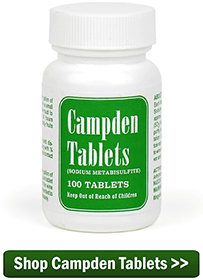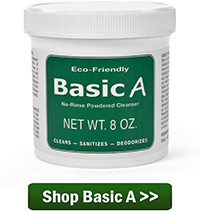How long can a finished homemade wine be stored or aged before going bad?
Gabe
—–
Hello Gabe,
There is nothing unique to homemade wine that makes it spoil or go bad any faster or keep any better than commercially made wines. As long as the homemade wine is treated properly, it will keep just as long and as good as wines you purchase at the store. So when you ask, how long does homemade wine last?, the simple answer is, just as long as any other wine!
But what does treated properly actually mean?
- It means your wine must be dosed with sulfites, and
- Your wine bottles must be sanitized before using
Treating Your Wine With Sulfites
This is very simple do and is very beneficial to the keeping qualities of the wine. If the wine is being made from fresh grapes or other fresh fruits, just add a standard dose of potassium metabisulfite or Campden tablets 24 hour before adding the yeast. If you are making wine from a wine concentrate this process can be skipped.
Another dose of potassium metabisulfite or Campden tablets should be added to the wine right before bottling. This dose before bottling goes for any wine – regardless if it’s made from fresh fruit or grape concentrate. There may be other times that sulfite should be added, depending on how many times the wine is being siphoned or how long it’s being bulk aged. You can find more information on this in the blog post: Using Campden tablets: The How, When And Why.
 By performing these simple steps your homemade wine will stay fresher much longer and will degrade in quality much slower. And, you will have have virtually eliminated the chance of your homemade wine experiencing out-right spoilage.
By performing these simple steps your homemade wine will stay fresher much longer and will degrade in quality much slower. And, you will have have virtually eliminated the chance of your homemade wine experiencing out-right spoilage.
Sanitizing Your Wine Bottles
This is the second part of the equation. How long does a homemade wine last? It depends on how well the wine bottles were sanitized. Fortunately, it’s a simple process.
All you have to do is clean the wine bottles as you normally would anyway. Use some dish soap and a wine bottle brush. If the wine bottles are brand new, you can skip this part. Then use a cleaners such as Basic A on the wine bottles to sanitize them. Both of these products come with complete directions on their usage. Once the wine bottles are mostly dry, they are ready to be filled with wine.
The wine bottle can be cleaned ahead of time, but the sanitation part should only be done when you are actually ready to bottle.
 Final Word…
Final Word…
It’s important to understand that these are the same critical steps that any winery would take. It’s what keeps all those bottles of wine consistently fresh on the store shelves, and that’s why your homemade wine can last just as long as any commercially made wine – stay fresh and free from going bad.
Follow these procedures. Make them habits. And you’ll never have a problem with any of your wines keeping while in storage.
Best Wishes,
Ed Kraus
—–
Ed Kraus is a 3rd generation home brewer/winemaker and has been an owner of E. C. Kraus since 1999. He has been helping individuals make better wine and beer for over 25 years.

Yes if everything Is treated right at bottling wine should be ok for 5-6 yrs. but the lower the ph the better it keeps. My wine at 5 yrs old is very good. Must keep at 55 degrees..have fun.
I have made wine since about 1976, including a lot of Santa Rosa Plum wine in 1982. It is still has great flavor and is a special occasion wine. I make my fruit wines as dinner wines as opposed to sweet wines, so like you have stated, if properly made and stored, homemade wine can last of a llllooonnngggg time. It was first stored under my parents home and is now in a my home’s stone cellar.
Is leaving wine in a refridgerator at 34degrees f a good thing or a bad thing? Thank you.
Kevin, storing wine at 34 degrees is neither a good or a bad thing. It will just take it longer to age at that cool of a temperature. The article posted below will discuss this in more detail.
Aging Homemade Wines
http://www.eckraus.com/blog/aging-homemade-wines
Living in the Philippines, wine is stored at 80 + deg F. I have had wine 2 years old, mostly because I drink it before it gets older. I don’t use sulphites. I sterilize with bleach only, and rinse well. I make small batches of wine, using a 5 liter fermentation bottle with only 4 1/2 liters of must. I do use pectic enzyme, yeast nutrient, and Ghostex or yeast energizer. The way I get wine to the flavor I like is by blending. It’s common to get identically made wines that are significantly different in flavor and sweetness, don’t ask me how that happens, but the soulution is to blend wines, the only criteria I use for blending is specific gravity. My flavor range is .995 to .997 SG. An SG of .998 to 1.001 is ok, but a little too sweet for me. I do get an occasional refermentation, the soulution to that is to use plastic drinking water bottles for wine bottles, they don’t explode, they just swell up a little.
Hello
I prepared wine like 14days ago (homemade) and i was wondering how long i should wait to bottle my wine. Also how i should store my wine. If i didnt add any sulphites to preserve within how many days should i consume it? Where should i store my bottled wine?
Thankyou
Cindy, your wine is ready to bottle once the fermentation complete, the wine has cleared and is free . The fermentation is complete once the specific gravity reading on your hydrometer reaches .998 or less. For more information see the article posted below. As far as how long the wine will keep if you do not add sulfites, we cannot say for sure. There are a couple of different things you can do to help keep the wine fresh as listed in the article posted below.
When Is My Wine Ready To Bottle
http://blog.eckraus.com/is-my-wine-ready-to-bottle
Making Wine Without Sulfites
http://blog.eckraus.com/making-wine-without-sulfites
I have a basic question. My apple wine has gone clear but there is a bottom sediment. Do I add sulphites and then rack in to bottles or do I rack off , add sulphites and then rack into bottles? If the former what is the best way of adding sulphites without disturbing the bottom sediment?
I am trying to disturb the wine as little as possible. As it stands I start with an open pot fermentation, then pour into an airlocked vessel . When fermentation is complete I rack off into another airlocked vessel and add pectalase and sulphites. The yeast drops but the wine remains cloudy. I add beaten egg white and the wine clears. It is the step after this that I am not sure about.
Stephen, you do not want to stir the sediment back up. You need to rack the wine leaving the sediment behind before adding anything to the wine.
I filter my wine while bottling using a gravity feed siphon. The wine rests from Sept-Oct until Nov-Dec. before testing and bottling.
Never have a problem with residue in the bottle or cloudiness.
Would you have a good recipe for a Saskatoon ( known as service berry ) wine?
Also a good chokecherry wine recipe? I’ve made wine with local recipes and am not impressed with the taste. I have all the berries froze and am ready to start soon. Hope to hear from you soon, and thank you in advance.
Are they choke berries (aronia) or choke cherries? You will increase the body and flavor by adding chopped raisins at about 1 pound raisins to 3 pounds aronia berries.
If I am going to bulk age my wine in a glass demijohn can I bottle the wine once I have done this?I would have added 1 Campden tablet to the 5 gallon demiohn at the start of the ageing process. Would I add another tablet before bottling?
Thanks for any advice you can give
Pete